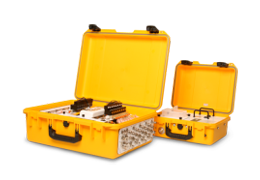Tanks of compressed air with known CO2 concentration and specified accuracy are readily available from commercial suppliers. Such tanks can provide convenient standards for checking the CO2 span of the LI-8100A; however, tanks are not available that contain a known water vapor concentration for checking the span of the water vapor channel. The LI-610 Portable Dew Point Generator can be used to provide air with a known dew point for the primary calibration of new analyzers. The span of the analyzer in the LI-8100A is stable when the zero is set on a regular basis, and soil CO2 flux measurements are not very sensitive to errors in the water vapor measurement. For these reasons, we recommend that you do not alter the span of the water vapor channel unless an LI-610 or similar equipment is used to produce an accurate H2O span gas.
Zero gases
Either CO2-free air or CO2-free nitrogen can be used as a zero gas. It is best to use a column filled with a chemical CO2 scrubbing agent downstream of the tank, however, as even "CO2-free" gases at times contain 10 or 20 ppm of CO2. Note that the scrubber may add significant H2O vapor, so you may want to use a water vapor scrubber downstream from the CO2 scrubber.
A suitable CO2 zero scrub is soda lime (part number 9964-090) and an H2O scrub is Drierite (part number 622-04299). When using chemical scrubbers, it is important to make sure that the chemicals are fresh. Always be sure to have a particulate filter installed in the air flow path between the chemicals and the instrument.
Compressed cylinders may be at pressures of several thousand pounds per square inch; before using them for calibration, they should be fitted with a regulator to reduce the pressure to around 15 pounds per square inch (101 kPa).
Carbon dioxide span gases
To set either the primary or secondary CO2 span, a cylinder of CO2 in air, verified to be accurate to within at least 1%, is ideal. Be cautious with a new cylinder, as the stated value of the calibration cylinder may be significantly different from the actual gas concentration, if the tank is mislabeled, for example.
For the primary span gas, choose a gas with a CO2 concentration slightly greater than the highest concentration encountered during measurements. The span and secondary span concentrations should be as far apart as possible, and they should bracket the concentration range of interest to you (e.g., 200 and 20,000, or 300 and 1500, etc.).
Water vapor span gases
For known water vapor concentrations, the LI-COR LI-610 Portable Dew Point Generator provides a stable dew point. To avoid condensation problems, choose a dew point temperature that is about 3 to 5 °C below the ambient temperature. Also, since water vapor sorbs and desorbs from surfaces, minimize the sorbing surface area (minimize tubing lengths), and allow plenty of time for the reading to stabilize. It is important not to rush through water vapor calibrations; give the surfaces 15 to 20 minutes to equilibrate to large changes in water vapor concentration.
